Skellingthorpe
| Skellingthorpe | |
 Skellingthorpe village |
|
 Skellingthorpe |
|
| Population | 3,444 (2001) |
|---|---|
| OS grid reference | SK924719 |
| – London | 125 mi (201 km) S |
| District | North Kesteven |
| Shire county | Lincolnshire |
| Region | East Midlands |
| Country | England |
| Sovereign state | United Kingdom |
| Post town | Lincoln |
| Postcode district | LN6 |
| Police | Lincolnshire |
| Fire | Lincolnshire |
| Ambulance | East Midlands |
| EU Parliament | East Midlands |
| UK Parliament | Lincoln |
|
|
Coordinates: 53°14′11″N 0°36′59″W / 53.236431°N 0.616514°W
Skellingthorpe is a village and civil parish in the North Kesteven district of Lincolnshire, England. It is situated 3 miles (5 km) west from Lincoln city centre, and just outside the A46 Lincoln ring road.
The village of Doddington and Doddington Hall lie 1 mile (1.6 km) to the south-west. Birchwood estate, built in the 1970s on the site of RAF Skellingthorpe, is 1 mile to the south-east.
History
Ancient
The earliest origins of the village are unknown. The area was probably marshland and woodland in the time of the Romans, and there is no evidence to suggest any permanent settlement by the ancient Britons, although it is possible that nomadic forest or swamp dwellers occasionally passed through.[1] However, Roman engineers building the canal now called the Foss Dyke would have been in the vicinity c. 120 AD. This is evidenced by the discovery of a Roman bowl in the parish, an image of which now features on the village sign.[2]
The Reverend G. S. Streathfeild suggests that Skellingthorpe itself may have originated with Danish occupiers.[3] The earliest known spelling of the manor's name (Scheldinchope) suggests an enclosure in marsh associated with a man named Sceld.[4] Around 1953 a blue and white ring (dated by the British Museum to c. 875 AD was found in Stoney Yard.[5]
The Domesday Survey
The Domesday Book (1086) records Skellingthorpe as "Scheldinchope", observing that it contained 12 carucates of land, worked by 18 villeins, two sokemen and four bordars. A meadow one mile long and two furlongs and a half broad is also mentioned here.[6] The Domesday Survey also noted that the ‘Soke’ (i.e. jurisdiction) of the manor of Skellingthorpe was claimed by one Balwin the Fleming, along with the manor of Doddington. His claim was disallowed, however, the jury finding that the manor belonged ‘rightfully’ to the Abbot of Westminster. [7]
13th century
There has been a place of worship in the village since the beginning of the 13th century: the institution of Robert de Weinflet as chaplain to the church of Skellingthorpe is recorded in 1225.[8]
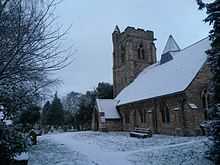
Patent Rolls for the year 1258 (dated 1 October) refer to the ‘Presentation of Master Raymond, the Queen’s physician, to the church of Skeldinghop in the king’s gift’. (Raymond’s appointment appears to have been a clerical one, at the direction of the Archbishop of Canterbury, the Diocese of Lincoln being historically linked to the Ecclesiastical Province of Canterbury.) [9]
Baldwin Wake
In the Middle Ages the manor of Skellingthorpe was held by the Norman Wak, or Wake, family. During the Wake's time, the Lincoln Assize of 29 April 1263 recorded a bitter dispute between ‘Henry, prior of St Katherine’s-without-Lincoln’ and ‘Brian, son of John’. The argument stemmed from the prior apparently being bound to ‘the service which Baldwin Wak demanded of him’ in respect of his ‘free tenement’ of land granted (by Baldwin) to the aforementioned Brian at Whisby. This Brian and Baldwin Wake seem to have been partisans, for Wake (being the lord of the manor) confiscated the prior’s property and ordered him ‘to do suit’ at his court of Scheldingope every three weeks. The squabble appears to have ended with the assizes taking the side of the prior, however, forcing ‘Brian’ to accept the Whisby lands were the property of the former. What Baldwin Wake thought about his authority being over-ruled was not recorded. [10] Following the Second Barons' War in England, Baldwin's lands – Skellingthorpe, Hykeham, Waddington and elsewhere – were seized by Antony Bek and Alexander de Montfort, two men entrusted by King Henry III with confiscating property owned by rebel supporters.[11] Baldwin was in further trouble during the reign of King Edward I, Henry’s successor, for he was charged with unjustly taking ‘consuetudines’ (customary tolls) from persons passing along the king's highway in the manor of Skellingthorpe, beyond the limits of his ownership. [12] He seems to have been deceased by 1283, for we learn that on 4 January that year the ‘manor of Skeldingho’ (and all Baldwin’s other lands) were granted to Edmund, Earl of Cornwall; although Hawisia – Baldwin’s wife – and others were allowed ‘their right in the said manor as adjudged in the king’s court’. [13]
Around this time, Walter de Stirchele and his wife Alice were granted a warren here, in which parties hunted hares and partridges.[14] (On the grant ‘to the said Walter and Alice and to his heirs male’, the manor bequeathed to them is written Skeldynghoppe.) [15]
14th century
In 1313, William de Kyme, the holder of the manor of Skeldinghope, was robbed by brazen thieves who broke open his chests and carried away his goods along with valuable documents. Initially, two suspects – ‘John de Bouynton and Alan Hak of Scorburgh’ – were outlawed for ‘trespasses committed against him (de Kyme) by them at Skeldynghope’. However, they were pardoned in 1315.[16]
Skellingthorpe, A View Through History (Mr L Stevens, 1974) picturesquely describes the parish in the intervening years between the Domesday Book and the late Tudor era: "It may not be any real exaggeration to say that for many of those 600 years time stood still; seed time and harvest; master and servant; and very little change. The villagers would watch the city of Lincoln grow to great importance and wealth, and then decline. The skyline would alter as the woods were cut to the west and south…The armies of Stephen, Matilda and various Dukes and Princes would pass by on their way to the city and the castle on the hill, and after a flurry of immediate interest, life in the village would go on as it had always done. Occasionally something may happen to bring variety to the monotony of everyday life. In 1317, for instance, the Rector of Skellingthorpe exchanged with the Rector of Thorpe. The old rector was John de Dardesby, and the incoming incumbent was one Roger Picot."[17]
In 1377, one of the Sisters of Bullington Priory, north-east of Lincoln, is listed as ‘Margery of Skeldinghop’. [18]
Squabbles over ownership
Throughout these centuries, much of Skellingthorpe’s history concerned the contested ownership of the parish, which was often argued far away from Lincolnshire itself. For instance, in 1382 a plea was heard before the king at Westminster asking him to adjudicate whether Elizabeth, wife of Edward le Despenser, had actually received a dowry consisting in part ‘of a hall and one carucate of land in Shelyngthorp’. Apparently, Elizabeth’s brother-in-law had bequeathed this to her, and (her husband being dead) she had requested ‘an inquisition’. It is not clear what the outcome was, nor whether her plea was successful. [19]
An early murder
In 1392 it was reported that one John Robyn, of Skeldynghope, lately imprisoned in the gaol of Lincoln Castle on a charge of murdering John de Ounesby of Aubourn, had been released. This followed testimony that Robyn had killed his enemy in self-defence. [20]
By February 1399 it was recorded during an inquisition at Lincoln that the manor of Skellingthorpe had become all but deserted, with much of the land remaining uncultivated through a lack of tenants. Therefore, that May the Rectory of Skellingthorpe was appropriated to the Hospital of Spital in the Street (the Spital Charity) by one Thomas de Aston (Canon of Lincoln), and they farmed out the rectorial tithes to laymen. The vicar was paid £5 a year by the charity.[21]
15th century
Lords of Kyme and the Burghs
By the 14th century the manor of Skellingthorpe had passed to the Tailboys (or Talboys) family, Lords of Kyme.[22] On the attainder of Sir William Talboys, Knight, his estates were escheated to the crown, and a portion of them, including Skellingthorpe, were granted by King Edward IV to Thomas Burgh in 1460.[23]
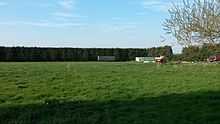
16th century
An interesting will
A will dated 21 April 1531 expressed a parish resident’s desire to be buried in St Lawrence’s Church (spelling modernised): I Edmund Knyght of Skellynghope being in whole mind and (to) save dreading death make my last will and testament. My body to be buried in the St Laurence of Skellynghope. Therefore I bequeath this. For forgotten tithes (£ amount). To our Lady warke of Lincoln (£ amount). To Hugh my son. To Howes my daughter. To Jenet my daughter. To Humphrey my son. To every one of my son’s children. To the vicar. The residue of my goods I give to my wife Jenet, and she to be my executrix, and Hugh my son with her, to dispose for the health of my soul. Witnesses thereof, Sir Robert Kyppas; James Langton; Bartholomew Tuffin. [24]
Deeds drafted c.1540 during the reign of King Henry VIII refer to the ownership of ‘two pastures culled Loundesyke and Freer Typpett in Stelyngthorp’. (The former may mean a field called The Lound, west of Lound Farm, Saxilby Road.) [25]
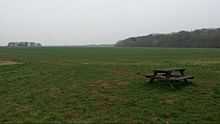
By the 1560s the manor had been inherited by Lord William and Lady Katherine Burgh;[26] but upon the death in 1597 of Thomas Burgh the manor of Skellingthorpe changed hands once again.[27]
17th century
The trials of Roger Fulshaw
In March 1610 the Court of the Star Chamber adjudicated on the case of a marauding clan said to have committed outrages in Lincolnshire. Thomas Clokes, Edmund Clapham, Mary Clapham (his wife), Ann Clapham, Elizabeth Clapham and Mary Clapham (their three daughters), Roger Tonge, John Daye, and others were accused of burglaries at Scothern; while in Skellingthorpe they were accused of forcibly entering the property of one Roger Fulshaw. Here, they allegedly seized bales of hay and plundered cattle from his land.[28] The victim in this case seems to have been the same Roger Fulshaw who found himself in trouble around this time following an unseemly and very violent brawl with a fellow called Rands in Skellingthorpe’s churchyard over an argument they had entered into. [29]
The Ferrers line
We learn that one Robert Farrar was made a Freeman of Lincoln on 3 November 1552, and he may have resided in Skellingthorpe, where a family of that name was settled at the beginning of the following century.[30] This was the Ferrers line, and they held the manor during the early 1600s. We learn that by 1625 one William Ferrers was providing £20 annually from the parish revenue to pay for the employment of a schoolmaster in Tewkesbury. [31] William was buried in Skellingthorpe itself on 4 August 1646. [32] He was succeeded by Sir Henry Ferrers of Skellingthorpe, who had been created a baronet in 1628. Henry was married to Anne Scudamore, and died in 1663. (The baronetcy became extinct upon the death of their son Henry Jnr in 1675.)[33] John Stone purchased the manor from Sir Henry in 1630, and upon John's death it passed to his widow, Katherine. However, since Sir Henry Ferrers had been a royalist during the English civil wars, whose lands were afterwards sequestered for his part in forming the King's garrison at Newark, Mrs. Katharine Stone and her son Henry underwent much trouble between 1650 and 1656 in saving the estate from being involved in this act of sequestration. [34]
Henry Stone
The manor was in turn inherited by Henry Stone. [35] In 1681, he began a suit against Lincoln's mayor and others for hindering the drainage of water into the Trent, thereby resulting in the flooding of several of his grounds in the parish.[36] Despite this conflict, a county guide book observes that Henry Stone was ‘a munificent benefactor to the charitable institutions of Lincoln and other places’.[37] He died aged 62 on 26 June 1693, and the following year the governors of 'Christ Hospitall' in London arranged for a tomb to be erected in his memory. This can now be seen in the grounds of the village church, with the wording on it still clearly visible. (Sadly, Henry’s two wives, two children and brother had all predeceased him, and because of this he had, in life, willed the estate of Skellingthorpe to Christ’s Hospital. His will also benefitted numerous neighbours and tenants, as well as local schools and the village church. In fact, his will was so broad that it necessitated an extensive survey of the parish’s acreage and worth in 1694 by bailiffs for Christ’s, as well as other surveys up until 1700 by Stone’s trustees.)[38]
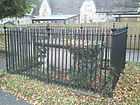
18th century
Throughout the latter 1600s and 1700s much of the parish economy stemmed from duck decoys, although this practice began to decline with the drainage and enclosure of the land.[39] However, the earthwork remains of one old Decoy Pond can still be found, although on private land.[40] Rabbit warrens also continued to be granted: the warrener’s house stood on ‘the Lord’s Moor’, Skellingthorpe, from at least 1694. [41]
Surveys by Christ's
In 1703 Christ’s sent inspectors to the village, to hear the villager’s complaints that Henry Stone’s tomb had been allowed to fall into a state of terrible neglect, while the new occupier of the Manor House – John Atkins – proved so inept that by 1723 the building was in a state of near ruination.[42]
In 1710, and due to these surveys, it was observed that the Skellingthorpe estate consisted of 2’872 acres let to fourteen different tenant farmers. Of this, 900 acres was ‘newly planted ground’, 600 was uncultivated and the rest was wooded land. [43]
A Skellingthorpe miracle?
A religious periodical, the Christian Amusement, reported in 1740 how, two years earlier at Easter, one Frances Wright, of ‘Skellingthorp, three miles from the city of Lincoln’, had fallen into a 48 hour trance during which she experienced a vision of both paradise and Hell, culminating in her transcendence to Heaven’s gates where she met ‘an old grave man’ with a bunch of keys and a book in his hand. Frances experienced another vision at Christmas 1738, in which she went to her niece’s house in Saxilby before taking her also to Heaven’s gates. The child is reported to have died ‘about this time’. In 1740, following a third vision over Whitsun, Frances took herself to Lincoln to receive the holy sacrament. (Upon each occasion Frances found herself transported initially to a riverside, and sceptics suggested she had been sleep-walking to the Foss Dyke.) [44]
Flooding
The parish of Skellingthorpe was extensively flooded in 1770, when entire stacks of hay were seen drifting between the village and Boultham.[45] But an even worse flood occurred in 1795 when the Trent burst its banks. For three weeks the village (including the Stones Arms inn) was under 6 feet of water. An interesting eye-witness account of this event was recorded in 1858, taken from Mary Millins, a village resident then aged 93: ‘The water came through the wood with a roaring noise, like the report of thunder. It came up to the Rundle Corner, in the village near the Maypole. A boat took people to market for three successive Fridays before the water subsided; I remember going to market in the boat…Ten calves were trapped on a small hill in the ox-pasture, a mile north of the village, and they had to be rescued by boat. They gave no trouble as expected, but rather clambered into the boat easily like good Christians, pleased to be rescued.’[46]
.jpg)
Up until the second half of the 18th century Skellingthorpe was pronounced and written ‘Skeldingthorpe’. A periodical in 1785 refers to the presentation of the Rev George Hare to the 'vicarage of Skellen-thorpe otherwise Skeldingthorpe, in the diocese of Lincoln’.[47]
It seems there was some excitement in the parish in June 1795, upon the announcement of the wedding of Mr Charles Allison (a Lincoln merchant) and one Miss Ashling, of Skellingthorpe. The Gentleman's Magazine observed their union in its column 'Domestic Occurrences: Marriages of Remarkable Persons.'[48]
19th century
In April 1807 the Gentleman’s Magazine reported the strange death in the village of ‘a strong young man’ named James Harrison. This person had been observed thrashing corn in a barn belonging to his master, Mr Michael Danby; not long afterwards he appeared in his master’s kitchen covered in blood and badly wounded, although he professed ignorance as to how he came by his injury. He died on the 26th in Lincoln County Hospital, and a coroner’s inquest judged he had somehow struck his own head with a flail he held.[49]
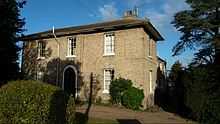
Attempts to establish Methodism
Initially-unsuccessful attempts were made to preach Methodism in Skellingthorpe. An early 19th century attempt by Wesleyans to establish a foothold ended in failure, and another attempt in 1817 ended equally unceremoniously at the first house they entered. Here, the steward of the manor ejected them, saying, 'The Governors of Christ's Hospital would have no Methodism upon any of their estates.' However, despite these setbacks 'a neat little chapel was soon erected in the village'.[50]

'Excellent farm houses' and high mortality
Thomas Allen's gazetteer of Lincolnshire describes the village in 1834: 'The village of Skellingthorpe, on the borders of Nottinghamshire, is distant about 7 miles westward from Lincoln. The church, dedicated to St Lawrence, is a discharged vicarage rated at £6 18 shillings and nine pence, endowed with 200 royal bounty, and £400 parliamentary grant. Here is also a place of worship belonging to the Wesleyan Methodists. In 1821, this parish contained 70 houses, and 370 inhabitants. Skellingthorpe is chiefly the property of Christ Church School in London. There are in this parish some excellent farm houses and buildings, as well as extensive plantations.'[51] The Lincolnshire Chronicle reported in 1865 that ‘within the last two or three years several houses had been erected on the outskirts of the village of Skellingthorpe, and owing to an obnoxious ditch in front of the tenements much fever and sickness had prevailed. Several deaths had taken place from fever, the last two being an old man and a child’.[52] The precarity of life in the village during the early 19th century can be gleaned from the parish register, which recorded 13 deaths in Skellingthorpe of children under ten throughout 1835.[53]
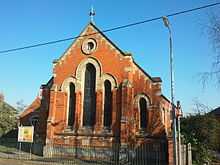
By the beginning of the 19th century large parts of the parish were still little more than a morass, and the risk of flood was a constant one: in June 1816, for example, the parish was once again completely deluged following a period of heavy rain that caused several local rivers to overflow their banks.[54] By the middle of the 19th century, however, Skellingthorpe had been well-drained for some time. Two small steam engines were even erected by this time near the Decoy Farm to pump out water in times of flooding.[55]
A village character
Thomas Miller's Pictures of Country Life (1847) observes the antics of a village character in his story 'Saint Saxby, of Skellingthorpe'. Saxby was an unpopular busybody, and Miller tells us that the villagers eased their boredom by playing tricks on him: on one occasion they placed a scarecrow in a man-trap Saxby had purchased to deter thieves from raiding his property. On another they led him to believe a murder had been committed, and he roused the whole village - only for the interred 'corpse' to turn out to be a buried sack of wood shavings. Apparently, Saxby exiled himself from the village not long after, in humiliation. These events, according to Miller, were said to have occurred some 50 years earlier; but it is unclear whether the narrative is a true one, or a fabrication merely situated in Skellingthorpe.[56]
Crimes and accidents
The 19th century newspapers recorded a number of other noteworthy events in the parish. The hideaway of two robbers who had lately escaped from Lincoln Gaol was discovered ‘in the dense plantation of Skellingthorpe’ in June 1833. Fox-hunters discovered the pair, named Freeman and Coupland, who had been living for six months in a bower formed of branches from trees, which was so well hidden as to defy detection until one was actually on the spot. It appeared the men had survived by poaching, and when the hideout was located ‘the shadows of two men were perceived flitting rapidly by some secret path from the wood’.[57]
A terrible murder was suspected on 24 June 1845 when a young man called William Parks was found fatally wounded in the stable of his master, Mr Ealand, farmer of Skellingthorpe. Before he died Parks claimed he had been dashed on the head with a hoe by a fellow employee named William Graham. Parks claimed the assault had been unprovoked, and although initially charged with murder, ‘the magistrate thought the case only amounted to manslaughter, and committed him (Graham) on that charge’.[58]
According to newspaper reports in January 1867, the Fossdyke was so frozen it allowed people to skate between Lincoln and Saxilby; tragically, two young Lincoln men were found frozen to death by Robert Hale, a PC stationed at Skellingthorpe. The discovery was made beside the Fossdyke in the vicinity of the end of Ferry Lane.[59]
In May 1869 it was reported that Mary Hollingsworth, a ‘servant with a farmer named Gask, of Skellingthorpe’, had been held on suspicion of murdering a newborn infant found dead in a privy. Mary confessed to her mistress that she had been pregnant, and (there being signs the infant had been born alive) she was arrested. A curious feature of the case is that ‘a piece of burnt wood had been placed under the tongue’ of the victim, a circumstance that greatly mystified all.[60]
On 30 September 1887 PC Williams (who had been stationed at Skellingthorpe for 16 years) was violently assaulted by a gang of poachers he encountered ‘near the Manor House’ early in the morning. The constable was viciously attacked and lucky not to have been killed. However, since he had recognised his assailants, it proved possible to arrest them, and they were subsequently brought to trial.[61]
20th century
In 1914 Christ's Hospital sold off all their properties in the parish, effectively ending a connection between Skellingthorpe and the capital that had existed for over 200 years.[62] To this day, a small number of buildings (including St Lawrence's School) still bear Christ's coat of arms on their gables or wall.
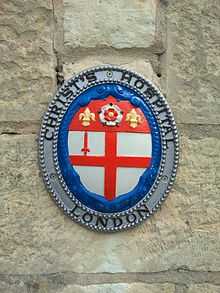
Zeppelin raid
During the 1915-1918 aerial bombardment of Britain by German Zeppelins, the parishes of Skellingthorpe and Doddington came under attack. During one sortie an L64 Zeppelin flew over Lincoln, which (being in darkness) escaped notice; at Skellingthorpe and Doddington, however, lights were still showing because the Lincoln sirens, from which these places received their warning of air raids, had not been heard. The lights attracted 14 bombs, which were dropped from 20’000 feet. These damaged an engine shed and a railway track at Skellingthorpe, but inflicted no damage beyond breaking glass at Doddington.[63]
Church fire
St Lawrence’s Church was rebuilt in 1855[64] and suffered a disastrous fire on Sunday 2 April 1916 that destroyed the interior, two of the bells, the organ, the pulpit, the font, cassocks and prayer books. Most significantly, the blaze destroyed ‘a list of vicars from the year 1297 up to the present time’. The fire was believed to have started in the heating apparatus under the organ chamber.[65]
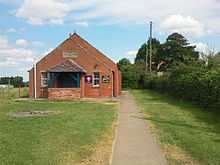
It was reported in 1925 that 'great surprise' had been caused in the village by the unexplained jilting of a 24-year-old village girl on the eve of her wedding day. Her future spouse had made arrangements with her to meet in Lincoln with a view to buying furniture for their new home; however, he never kept the appointment, and on the day of the wedding he was still absent. The young woman was at a loss to explain why he had deserted her.[66]
The parish during the war
A war memorial in the church grounds shows that the village lost 19 men during the Great War, and a further five during the Second World War. There was great solidarity between parishioners and those stationed at the nearby RAF base during the war, particularly when serious incidents occurred. (Two disastrous accidents involving bombers and their payloads occurred in 1945, each time accompanied by a tremendous explosion.[67]) This solidarity can be evidenced by the fact that, following the war, all those who served on the base were granted the Freedom of Skellingthorpe, and a copy of this declaration can now be seen within the village’s Heritage Room. A plaque was also subsequently erected near the current Community Centre and Youth Hall by the people of the parish; this was dedicated to the memory of ‘the airmen and women’ of 50 and 61 Squadrons who served at RAF Skellingthorpe during 1941-1945. The plaque can be found opposite the Heritage Room and bears a poignant poem by RW Gilbert: My brief sweet life is over; My eyes no longer see; No Christmas Tree, No Summer walks, No pretty girls for me; I’ve got the chop, I’ve had it: My nightly ops are done; Yet in another hundred years, I’ll still be twenty one.
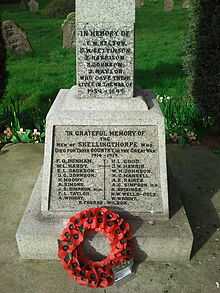
Bomber crash
The area was the scene of a major accident on Friday 15 July 1949. An RAF Bomber that had taken off from Waddington came down 15 minutes later, crashing in flames near Skellingthorpe. Seven people were killed: Pilot Officer RG Ratcliffe (pilot); Flt-Lt RH Knight (navigator); G McCarthy (navigator); MG Waterfall (navigator); JW Adamson (signaller); CS Brett (gunner) and FG Searle (gunner). The crash occurred in a field a quarter of a mile away from an RAF bomb dump.[68] (The site of the bomb storage area was at Skellingthorpe Moor Plantation, to the south of the village.)[69]
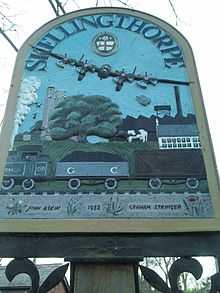
The first telephone in Skellingthorpe was installed in 1925, in ‘Sturdy’s shop’ (a local tailor). Electricity and running water came in the 1930s, with the first lot of street lights being erected in 1956-57. Main drainage came in 1964.[70]
Railway station
The east-west Lancashire, Derbyshire and East Coast Railway used to pass through the village, heading west through Ollerton in Nottinghamshire. The line was built in 1897 and carried freight until 1979. (In 1916 King George V and Queen Mary slept in the Royal Train at Skellingthorpe Sidings while visiting Lincoln during the Great War. The children of St Lawrence’s School were brought one morning by the headmaster, Mr Brooks, to sing the National Anthem to the royal visitors. It is said the king requested the second verse, but since the children did not know it they were compelled to sing the first verse again! Had there been an air-raid during these sleepovers there was a contingency to drive the Royal Train into Bolsover Tunnel, Derbyshire.)[71] Skellingthorpe railway station closed in 1955. The line is now a cycle path on a National Cycle Route.
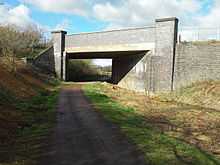
21st century
In 2005 the village made national headlines when church concerns about a planned 'Harry Potter day' for local schoolchildren forced the cancellation of the event. It had been intended that the children would dress up as wizards and witches, and learn pretend spells and potions, in an event designed to coincide with the launch of the latest book in the series.[72]
In April 2006 a marked police vehicle chasing a suspect vehicle (following an incident near the A46 Doddington roundabout) left the road and crashed into the front of a house in Skellingthorpe. The occupants were inside at the time, although luckily they were unhurt during the incident. The two officers received minor injuries.[73]
Jerusalem Road was closed for five days between 11 and 16 April 2008 following an incident in which a lorry spilled animal waste onto the road's surface. Following reports of cars skidding on the offal and fat, the county council used absorbent material to clear the route. A similar accident some years before had resulted in the entire road being resurfaced.[74]
Due to its proximity to the epicentre, Skellingthorpe was one of the many places rattled by the 2008 Lincolnshire earthquake.
Factory fire
On 26 July 2010 a bone-meal factory in the parish was rocked by a ‘massive’ explosion and fire that forced ten night-shift workers to flee for their own safety. The blast – believed to have been caused by an accidental ‘dust explosion’ - literally shook the village, according to the Lincolnshire Echo. Flames leapt 50ft high and it took ten fire crews from Lincolnshire and Nottinghamshire to bring the major incident under control. A second fire at the same plant occurred in the early hours of 16 August 2011, preceded by two ‘large bangs’. This time, six fire crews took about four hours to quell the blaze.[75]
Pet owners in the village were alarmed by a spate of deliberate attacks on cats in 2011. Reports were logged of pets being poisoned, trapped in cages and doused in freezing water, and in at least one instance shot dead with an air-rifle. Lincolnshire police said it was taking the incidents very seriously.[76]
Today's community
According to the 2001 Census, Skellingthorpe had at the time a population of 3,444 people. Parishioners are served by a popular magazine, Skellingthorpe Chatterbox (est. 1987), and also News NK, a newspaper that caters for all North Kesteven residents.
Notable buildings
Skellingthorpe Hall is to the east of the village. Pevsner describes the hall as, 'A Greekly august house of the early C.19. The porch is particularly good, with pilasters at the angles and fluted Greek Doric columns in antis with a finely-carved frieze behind them above the entrance'.[77] The hall is a Grade II Listed Building.[78] The Manor House is also a Grade II Listed Building, dating from around 1811, which formerly went by the name of ‘West Manor’. [79] (This is not the original Manor House building referred to above as having fallen into near-ruination by 1723.) On Church Road can be found the Grove Care Centre: this building was formerly ‘Skellingthorpe Farm’ and (according to a plaque on its western wall) was built in 1813. Off Lower Church Road, Jessop’s Cottage is believed to be the oldest cottage in the village; [80] an 1840 Commissioner’s Report observes one ‘John Jessop’ lived there in 1837. [81]
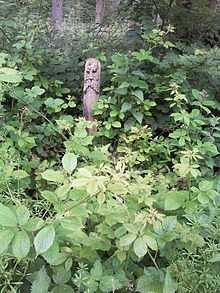
Old Wood
Old Wood is to the west. Old Wood is (as its name would suggest) an ancient woodland forming part of the Witham Valley Country Park. In the Middle Ages it was used as a deer park. [82] An 1847 county guidebook observes of the bird-life in the parish: ‘The extensive wood is frequented by the fork-tailed kite, and used to possess a heronry.’ [83] In 1933 the wood was the home of a large brown, or 'white-tailed', eagle with a seven-foot wingspan. Unfortunately, it migrated south and was shot near Sleaford following a series of attacks on farmer's livestock there.[84] The woodland is now owned and managed by the Woodland Trust. It is a varied site with a mixture of ancient oak, lime woodland and conifers. The woodland also has a high conservation value which will develop further as the conifer areas, which were planted during the 1950s and 1960s, are replaced by native species. The site boasts a wide variety of seasonal flora including twayblade, early-purple orchid, and lily-of-the-valley. A wide variety of wildlife exists within the wood: sizable buzzards are seen in the daytime, owls can often be heard at dusk and deer have also been spotted among the trees.[85] Snake-like slow worms are sometimes found at the bottom of resident's gardens. To the west of the village, Old Wood merges with the smaller Old Hag Wood.
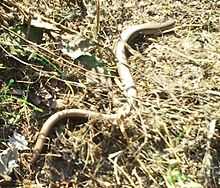
Amenities and activities
There are two village public houses: the Stones Arms (named after Henry Stone) and the Plough Inn, both on High Street. Every Wednesday a fish and chip van visits the community centre. There are three football teams in the village, FVA Jerusalem, Skellingthorpe Plough (adult team) and St. Helens (child team). On Lincoln Road can be found the Daisy Made real dairy ice cream and coffee shop. The Village Hall is on High Street and is now used by the local scouts as their HQ, and a small Heritage Room at the Community Centre houses a collection of photographs showing the development of RAF Skellingthorpe. There is a library on Church Road. The village also has two schools: St Lawrence’s Primary School (established 1855) and the Holt Primary School, which dates to 1970. There are a number of Neighbourhood Watch coordinators in the village.
Annual fete
The land south of Church Road is a Recreation Ground called Monson Field. In June 2014 this playing field was the setting for Skellingthorpe's annual Village Gala. The gala, which has been a feature of the village for the past few years, comprises numerous attractions: stalls, a lorry pull, live music and a flypast by a Spitfire featured at the 2014 event. The 2008 gala saw a charity race between pantomime animals that included six pantomime horses, a camel, a reindeer and a cow. With two people inside each costume, the event proved a comical hit with those attending.[86][87]
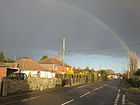
Jerusalem
The road south-west of the village is called Jerusalem Road. This leads to Lincoln Road via a distinct hamlet called Jerusalem. It is unclear how the hamlet came by this name, although an early 19th-century Ordnance Survey map shows there was at one time a small Victorian-era Methodist chapel sited between two bends in the road.[88] (This should not be confused with the Methodist church that can be found on High Street in the village itself, which only dates to 1894. Nor should it be confused with the one referred to in Thomas Allen’s gazetteer (see above), since this stood on Wood Bank.)[89]
Village folklore
According to a village tradition, the local farmer Henry Stone was working the fields here when he was forced to take shelter beneath a great oak tree during a thunderstorm in 1690. Two times his pet dog attempted to drag him away from the oak, succeeding upon the third attempt: at that exact moment a flash of lightning hit the tree, killing a pheasant that had sought shelter in its branches. To commemorate his curious deliverance, Henry Stone had a picture painted of the tree, the pheasant and his dog. This picture, dated 1693, survives in the Drawing Room of nearby Doddington Hall, Lincolnshire.[90] It is possible the painting inspired the story, rather than the other way round, but it is now sometimes said that the faithful dog's ghost can be seen near the railings that enclose Henry's tomb.[91] Latterly, other kinds of folklore have occasionally become village talking points. These include a ghost supposedly seen on Old Chapel Road[92] and a large cat-like animal seen in 1997.[93] Daniel Codd's Mysterious Lincolnshire contains another account of a village ghost, this time seen within a house in 2002.[94] In 2009, a village resident glimpsed an unidentified aerial phenomenon, or 'UFO'.[95]
References
- ↑ Stevens, L (Skellingthorpe Evening Institute). Skellingthorpe, A View Through History. (1974). p.4.
- ↑ http://www.flickr.com/photos/91962644@N07/8402539308/
- ↑ Streatfeild, Reverend G. S. (1884). Lincolnshire and the Danes.p.86
- ↑ Mills, A. D. (2003); A Dictionary of British Place-Names. Oxford University Press. ISBN 0198527586
- ↑ Stevens, L (Skellingthorpe Evening Institute). Skellingthorpe, A View Through History. (1974). p.58.
- ↑ Gowan Smith, Charles. (1870). A Translation of that Portion of Domesday Book that Relates to Lincolnshire. p.228-229
- ↑ Reports and Papers of the Architectural and Archaeological Societies of the Counties of Lincoln and Northampton, Volume 20, p.269, (1889)
- ↑ Reports and Papers Read at the Meetings of the Architectural Societies of the Counties of Lincoln and Nottingham, etc, Vol.24 (Associated Architectural Societies, 1897). p.402.
- ↑ Patent Rolls of the Reign of Henry III.: 1247-1258, p.652, GB Public Record Office (1908)
- ↑ The Publications of the Lincoln Record Society, Volume 17, p.198 (1920)
- ↑ Hill, Sir Francis. Medieval Lincoln (1948). Cambridge University Press. p.210. ISBN 9780521079259
- ↑ Reports and Papers of the Architectural and Archaeological Societies of the Counties of Lincoln and Northampton, Volume 20, p.269, (1889)
- ↑ Calendar of the Patent Rolls Preserved in the Public Record Office, Volume 8, p.53 (1893)
- ↑ Moor, Charles. Knights of Edward I (1929). p.35.
- ↑ Calendar of the Close Rolls Preserved in the Public Record Office, Volume 4, p.245, H.M. Stationery Office (1937)
- ↑ Patent Rolls preserved in the Public Record Office. 1313-1317. p.62, 272 (Kraus reprint, 1971)
- ↑ Stevens, L (Skellingthorpe Evening Institute). Skellingthorpe, A View Through History. (1974). p.4.
- ↑ Women in England: c. 1275-1525, p.277, PJP Goldberg (1995). ISBN 978-0-7190-4056-6
- ↑ Calendar of the Close Rolls Preserved in the Public Record Office: Richard II, A.D. 1377-1399, Volume 2, p.67 (1972)
- ↑ Calendar of the Patent Rolls preserved in the Public Record Office (Richard II, Volume V 1391-1396), p.192 (pub. 1905 by Mackie and Co. Ltd., 69 Fleet Street)
- ↑ Stevens, L (Skellingthorpe Evening Institute). Skellingthorpe, A View Through History. (1974). p.4.
- ↑ Proceedings of the Society of Antiquaries of London, Volume 3 (ed. Society of Antiquaries of London). (1865) p.244-245.
- ↑ Oldfield, Edmund. A Topographical and Historical Account of Wainfleet and the Wapentake of Candleshoe (1829). p.134.
- ↑ The Publications of the Lincoln Record Society, Volume 24, p.133, Lincoln Record Society (1930)
- ↑ Letters and Papers, Foreign and Domestic, of the Reign of Henry VIII: Preserved in the Public Record Office, the British Museum, and Elsewhere in England, Volume 15, p.404 (1896)
- ↑ Frere, John. Catalogue of the ... collection of autograph letters and MSS ..., Volume 5 (1866). p.6.
- ↑ John Hodgett, Gerald Augustus. Tudor Lincolnshire (1975). p.166.
- ↑ The National Archives, Kew. Public Record. Category: STAC 8 Court of Star Chamber: Proceedings, James I (c1558-c1649). Ref: STAC 8/141/28. http://discovery.nationalarchives.gov.uk/browse/r/h/C5571161
- ↑ Reports and Papers, Volume 25, p.261, Associated Architectural Societies (1899)
- ↑ Bindoff, S. T. (1982). The House of Commons 1509-1558. Haynes Publishing. p.118. ISBN 0436042827
- ↑ The History and Antiquities of Tewkesbury, p.15, William Dyde (1790)
- ↑ Maddison, A. R. (1906). Lincolnshire Pedigrees. p.1340.
- ↑ Courthope, William John. (1835). Synopsis of the Extinct Baronetage of England. p.77.
- ↑ Reports and Papers, Volume 25, p.302, Associated Architectural Societies (1899)
- ↑ Architectural Societies. (1899). Reports and Papers Read at the Meetings of the Architectural Societies… p.302.
- ↑ Hill, JWF. Tudor and Stuart Lincoln (1954). p.209.
- ↑ R. E. Leary (printers). The Hand Book Guide to Lincoln and the Neighbourhood (third edition). p.65
- ↑ Stevens, L (Skellingthorpe Evening Institute). Skellingthorpe, A View Through History. (1974). p.5-7, 58.
- ↑ Stevens, L (Skellingthorpe Evening Institute). Skellingthorpe, A View Through History. (1974). p.7-8.
- ↑ http://www.lincstothepast.com/Skellingthorpe-duck-decoy--550m-north-east-of-Decoy-Farm/230147.record?pt=S
- ↑ English rural communities: the impact of a specialised economy, p.86, Denis Mills (1973). ISBN 978-0333149621
- ↑ Stevens, L (Skellingthorpe Evening Institute). Skellingthorpe, A View Through History. (1974). p.13.
- ↑ Report of the Commissioners appointed in pursuance of an Act of Parliament (32 pt. VI), p.155, Commissioners for Inquiring Concerning Charities (dated 30 June 1837)
- ↑ The Christian's amusement, Volume 1 (Issue No.10), p.1-2, pub. John Lewis (1740)
- ↑ Stevens, L (Skellingthorpe Evening Institute). Skellingthorpe, A View Through History. (1974). p.71.
- ↑ Padley, James Sandby. The Fens and Floods of Mid-Lincolnshire (1882). p.6-7.
- ↑ The London Magazine (Volume the Fourth from January to June 1785), Isaac & Edmund Kimber (1785) p.150
- ↑ The Gentleman's Magazine & Historical Chronicle (Volume 65, Part 1). (1795). p.526.
- ↑ Nichols, John. Gentleman’s Magazine (Vol.101). April 1807. p.379.
- ↑ Watmough, Abraham. A History of Methodism in the Neighbourhood and City of Lincoln. (1829). p.103.
- ↑ Thomas Allen. The History of the County of Lincoln: from the Earliest Period to the Present Time. (1834). p.266-267.
- ↑ Lincolnshire Chronicle (22 September 1865) p.8
- ↑ Stevens, L (Skellingthorpe Evening Institute). Skellingthorpe, A View Through History. (1974). p.23.
- ↑ The Monthly Magazine, or British Register (Volume 41, Pt. 1 for 1816). (1816). p.473.
- ↑ Clarke, John Algernon. On the Farming of Lincolnshire. (1852). p.51.
- ↑ Miller, Thomas. Pictures of Country Life: and Summer Rambles in Green and Shady Places. (1847). p.183-200.
- ↑ Yorkshire Gazette p. 3 (29 June 1833), citing Stamford News
- ↑ Lincolnshire Chronicle (4 July 1845) p.2
- ↑ Notts Guardian (11 January 1867) p.12
- ↑ Sheffield Daily Telegraph (8 May 1869)
- ↑ Lincolnshire Chronicle (14 October 1887) p.2
- ↑ Wilkins, Harold Tom. Great English Schools. (1925). p.287.
- ↑ Sir Walter Alexander Raleigh, Henry Albert Jones. The War in the Air (1935). p.124.
- ↑ http://www.genuki.org.uk/big/eng/LIN/Skellingthorpe/
- ↑ Grantham Journal (8 April 1916)
- ↑ Dundee Courier. p.5 (5 October 1925).
- ↑ Further data available in Skellingthorpe Heritage Room, http://raf-lincolnshire.info/skellingthpe/skellingthpememorial.htm
- ↑ The Gloucester Citizen (16 July 1949) p.1
- ↑ North Kesteven District Trail: Lincolnshire. NKDC publication (DESA Ltd), Nottingham. p.39.
- ↑ Lincolnshire Echo (The Gossiper column). (6 June 1974). p.8.
- ↑ Stevens, L (Skellingthorpe Evening Institute). Skellingthorpe, A View Through History. (1974). p.53.
- ↑ Daily Mirror (5 July 2005)
- ↑
- ↑
- ↑ Lincolnshire Echo (27 July 2010, 16 August 2011)
- ↑ Lincolnshire Echo (10 May 2011)
- ↑ Pevsner, Nikolaus. The Buildings of England (Lincolnshire). (1964, 2nd ed.1989). p.646. ISBN 0300096208
- ↑ http://www.britishlistedbuildings.co.uk/en-192264-skellingthorpe-hall-skellingthorpe-linco
- ↑ http://www.britishlistedbuildings.co.uk/en-192263-manor-house-skellingthorpe-lincolnshire
- ↑ http://www.n-kesteven.gov.uk/visitors/leisure/sports-and-leisure/countryside/walks/village-walks/skellingthorpe-village-walk/105918.article
- ↑ Report of the Commissioners appointed in pursuance of an Act of Parliament for Inquiring Concerning Charities (dated 30 June 1837), p.209 (pub. 1840 by W Clowes & Sons of Stamford Street
- ↑ http://withamvalleypark.co.uk/your-visit/witham-valley-country-park/skellingthorpe-old-wood
- ↑ A Short Guide to the County of Lincoln, p.7, Sir Charles Henry John ANDERSON (1847)
- ↑ Hull Daily Mail. (24 March 1933). p.13.
- ↑ http://withamvalleypark.co.uk/your-visit/witham-valley-country-park/skellingthorpe-old-wood
- ↑ Lincolnshire Echo (23 June 2008)
- ↑ Skellingthorpe Chatterbox No.319. (parish magazine). August 2014.
- ↑ Skellingthorpe Chatterbox No.277. (Parish magazine). February 2011. p.6
- ↑ Stevens, L (Skellingthorpe Evening Institute). Skellingthorpe, A View Through History. (1974). p.50.
- ↑ Codd, Daniel (2007). Mysterious Lincolnshire. Breedon Books. p. 136. ISBN 9781859835630.
- ↑ Felix, Richard. (2006). The Ghost Tour of Great Britain: Lincolnshire. Breedon Books Publishing. p.113. ISBN 1859835074
- ↑ Skellingthorpe Chatterbox No 277. (Parish magazine). February 2011. p.19.
- ↑ Fortean Times Issue 101 (1997). John Brown Publishing. p.25
- ↑ Codd, Daniel. Mysterious Lincolnshire. p.128. Breedon Books Publishing Co Ltd. ISBN 9781859835630.
- ↑ http://www.ufoinfo.com/sightings/uk/091022a.shtml
External links
 Media related to Skellingthorpe at Wikimedia Commons
Media related to Skellingthorpe at Wikimedia Commons- St Lawrence's church
- North Kesteven office on Lincoln Road
- Skellingthorpe & District Motorcycle club
- Pictures of Skellingthorpe
- St Lawrence CE Primary School
- Holt Primary School
- Skellingthorpe in the Domesday Book
| ||||||||||||||||||||||